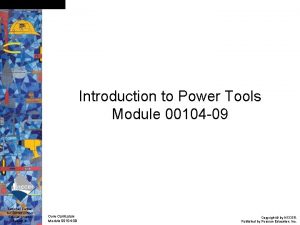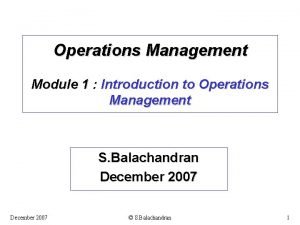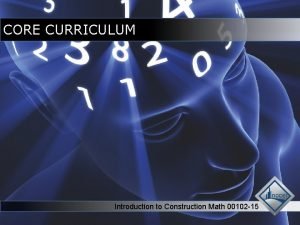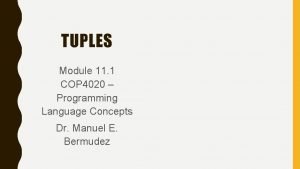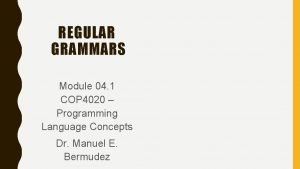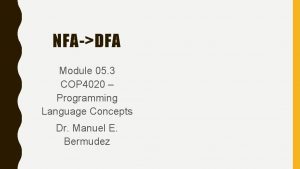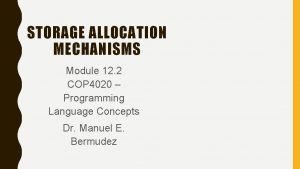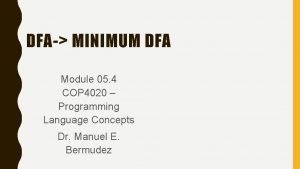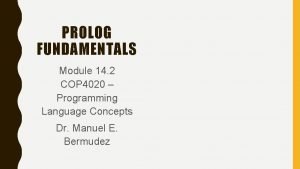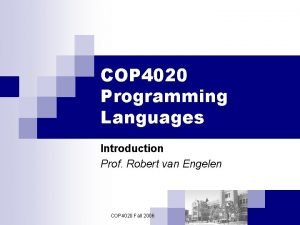INTRODUCTION TO RPAL Module 10 1 COP 4020













- Slides: 13

INTRODUCTION TO RPAL Module 10. 1 COP 4020 – Programming Language Concepts Dr. Manuel E. Bermudez

TOPICS The RPAL Language No assignment No sequencing No iteration No “memory” Only expressions: every RPAL program is an expression. To run an RPAL program is to evaluate it. “Turing complete”

RPAL IS A SUBSET OF PAL • PAL: Pedagogic Algorithmic Language. • Developed by J. Wozencraft and A. Evans at MIT, early 70's. • R(ight-reference)PAL ⊂ L(eft-reference)PAL ⊂ J(ump) PAL • Intellectual ancestor of Scheme, (Guy Steele, mid-70's) – Steele (Sun Microsystems): principal contributor to Java. – Google: 'Guy Steele Scheme‘. • Why Study RPAL ? – Generic, “plain vanilla” functional language. – Unknown language (to you) – Paradigm shift !!

SIMPLE ONE-LINE RPAL PROGRAMS 3 //comment: value is 3, print nothing (3+1)*4**2 // arithmetic: value is 64, prints nothing ’Hello World’ // value is ’Hello World’ Print(’Hello World’) // Prints ’Hello World’, value is dummy Print(Conc ’Hello ’ ’World’) // same 4*6 < 27 // value is true (not ’true’) 2 < 0 -> 3 | 6 // conditional (like the ? : operator) true or false // value is true & false // value is false, & is the ‘and’ operator

DATA TYPES AND OPERATORS • Integer operations: +, -, *, /, **, eq, ne, ls, <, gr, >, le, <=, ge, >= • Truthvalue (boolean) operations: or, &, not, eq, ne • String operations: eq, ne, Stem S, Stern S, Conc S T • Conditional operator: -> | • Elementary values: <int>, <id>, true, false

OPERATOR PRECEDENCE Operator Precedence -> or & not gr ge le ls eq ne + - (unary and binary) * / ** () Elements: Low High Associativity Right Left None Left Right Embedded <id>, <int>, <str>, true, false, dummy

NEW DATA TYPE: FUNCTION (FN X. B) Has a ’bound variable’ (parameter), and a body. Example: fn X. Print(X**2) It’s value: “Nameless, typeless function with typeless parameter X, that prints X squared. ” fn N. N ls 0 -> -N | N Value: “Nameless, typeless function with typeless parameter N, that returns |N|. ” fn x. fn y. x+y fn x y. x+y or, equivalently Value: “Nameless, typeless function that takes typeless parameter x, and returns nameless, typeless function that take typeless parameter y, and returns x+y. ”

FUNCTION APPLICATION Function application is by juxtaposition. Example: (fn X. Print(X**2)) 3 Function is applied to 3. 3 replaces X in expression Print(X**2), yielding Print(3**2), yielding Print(9), yielding dummy (and prints 9).

FUNCTION APPLICATION Example: (fn N. N ls 0 -> -N | N) (-3) replaces N in (N ls 0 -> -N | N), yielding ((-3) ls 0 -> -(-3)|(-3)) ), yielding –(-3) = 3 Function application is left associative: Example: (fn x. fn y. x+y) 3 2 (fn y. 3+y) 2 3+2 5 yielding

TYPE IDENTIFICATION FUNCTIONS • Intrinsic functions. • Applied to a value, return true or false: • Isinteger x • Istruthvalue x • Isstring x • Istuple x • Isfunction x • Isdummy x

RPAL CONSTRUCTS • Operators • Function definitions • Constant definitions (parameterless function) • Conditional expressions • Function application • Recursion

RPAL HAS SIX DATA TYPES: • Integer • Truthvalue (boolean) • String • Tuple (coming soon) • Function • Dummy (value: dummy) • RPAL is dynamically typed: – the type of an expression is determined at run-time. – Example: let Funny = (B -> 1 | ’January’) in Print(Funny)

SUMMARY RPAL Language of expressions To run it, evaluate it. Arithmetic, boolean, string operations. New data type: function. New operation: function application.
 Good cop bad cop interrogation
Good cop bad cop interrogation Cop 1 cop 2
Cop 1 cop 2 Contoh surat bayaran balik emolumen
Contoh surat bayaran balik emolumen As nzs 4020
As nzs 4020 Center for army analysis
Center for army analysis C device module module 1
C device module module 1 Introduction to power tools module 4
Introduction to power tools module 4 Module 5 introduction to construction drawings
Module 5 introduction to construction drawings Nccer introduction to construction drawings
Nccer introduction to construction drawings Operations module
Operations module Dr carlson advises his depressed patients
Dr carlson advises his depressed patients Module 00103 exam introduction to hand tools
Module 00103 exam introduction to hand tools 00102-15 introduction to construction math
00102-15 introduction to construction math 00105-15 introduction to construction drawings
00105-15 introduction to construction drawings






